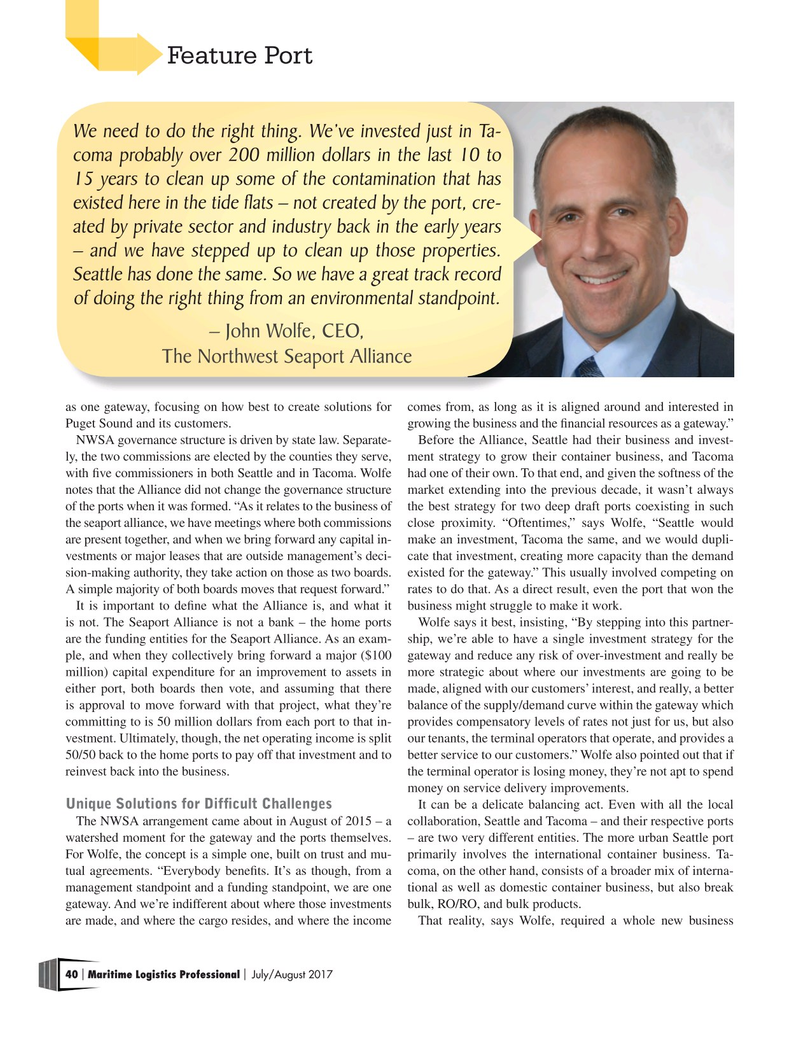
Page 40: of Maritime Logistics Professional Magazine (Jul/Aug 2017)
PORTS & INFRASTRUCTURE
Read this page in Pdf, Flash or Html5 edition of Jul/Aug 2017 Maritime Logistics Professional Magazine
Feature Port
We need to do the right thing. We’ve invested just in Ta- coma probably over 200 million dollars in the last 10 to 15 years to clean up some of the contamination that has existed here in the tide fats – not created by the port, cre- ated by private sector and industry back in the early years – and we have stepped up to clean up those properties.
Seattle has done the same. So we have a great track record of doing the right thing from an environmental standpoint. – John Wolfe, CEO,
The Northwest Seaport Alliance as one gateway, focusing on how best to create solutions for comes from, as long as it is aligned around and interested in
Puget Sound and its customers. growing the business and the fnancial resources as a gateway.”
NWSA governance structure is driven by state law. Separate- Before the Alliance, Seattle had their business and invest- ly, the two commissions are elected by the counties they serve, ment strategy to grow their container business, and Tacoma with fve commissioners in both Seattle and in Tacoma. Wolfe had one of their own. To that end, and given the softness of the notes that the Alliance did not change the governance structure market extending into the previous decade, it wasn’t always of the ports when it was formed. “As it relates to the business of the best strategy for two deep draft ports coexisting in such the seaport alliance, we have meetings where both commissions close proximity. “Oftentimes,” says Wolfe, “Seattle would are present together, and when we bring forward any capital in- make an investment, Tacoma the same, and we would dupli- vestments or major leases that are outside management’s deci- cate that investment, creating more capacity than the demand sion-making authority, they take action on those as two boards. existed for the gateway.” This usually involved competing on
A simple majority of both boards moves that request forward.” rates to do that. As a direct result, even the port that won the
It is important to defne what the Alliance is, and what it business might struggle to make it work.
is not. The Seaport Alliance is not a bank – the home ports Wolfe says it best, insisting, “By stepping into this partner- are the funding entities for the Seaport Alliance. As an exam- ship, we’re able to have a single investment strategy for the ple, and when they collectively bring forward a major ($100 gateway and reduce any risk of over-investment and really be million) capital expenditure for an improvement to assets in more strategic about where our investments are going to be either port, both boards then vote, and assuming that there made, aligned with our customers’ interest, and really, a better is approval to move forward with that project, what they’re balance of the supply/demand curve within the gateway which committing to is 50 million dollars from each port to that in- provides compensatory levels of rates not just for us, but also vestment. Ultimately, though, the net operating income is split our tenants, the terminal operators that operate, and provides a 50/50 back to the home ports to pay off that investment and to better service to our customers.” Wolfe also pointed out that if reinvest back into the business. the terminal operator is losing money, they’re not apt to spend money on service delivery improvements.
It can be a delicate balancing act. Even with all the local
Unique Solutions for Diffcult Challenges
The NWSA arrangement came about in August of 2015 – a collaboration, Seattle and Tacoma – and their respective ports watershed moment for the gateway and the ports themselves. – are two very different entities. The more urban Seattle port
For Wolfe, the concept is a simple one, built on trust and mu- primarily involves the international container business. Ta- tual agreements. “Everybody benefts. It’s as though, from a coma, on the other hand, consists of a broader mix of interna- management standpoint and a funding standpoint, we are one tional as well as domestic container business, but also break gateway. And we’re indifferent about where those investments bulk, RO/RO, and bulk products.
are made, and where the cargo resides, and where the income That reality, says Wolfe, required a whole new business 40 Maritime Logistics Professional July/August 2017 | |

 39
39

 41
41
